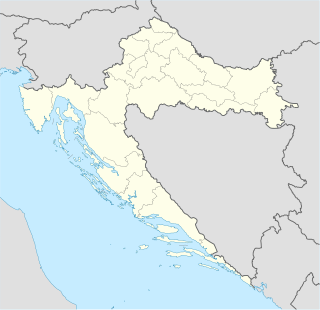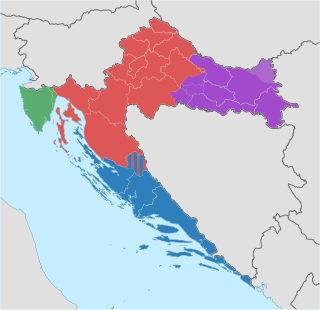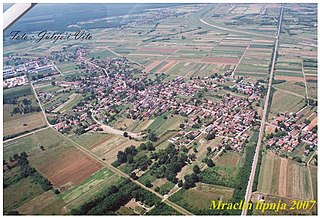Turopolje | |
|---|---|
Village | |
| Coordinates: 45°38′56″N16°8′24″E / 45.64889°N 16.14000°E | |
| Country | |
| Region | Central Croatia |
| County | Zagreb County |
| Municipality | Velika Gorica |
| Population (2011) [1] | |
| • Total | 953 |
| Time zone | UTC+1 (CET) |
| • Summer (DST) | UTC+2 (CEST) |
Turopolje | |
|---|---|
Village | |
| Coordinates: 45°38′56″N16°8′24″E / 45.64889°N 16.14000°E | |
| Country | |
| Region | Central Croatia |
| County | Zagreb County |
| Municipality | Velika Gorica |
| Population (2011) [1] | |
| • Total | 953 |
| Time zone | UTC+1 (CET) |
| • Summer (DST) | UTC+2 (CEST) |

The demographic characteristics of the population of Croatia are known through censuses, normally conducted in ten-year intervals and analysed by various statistical bureaus since the 1850s. The Croatian Bureau of Statistics has performed this task since the 1990s. The latest census in Croatia was performed in April 2011. The permanent population of Croatia at the 2011 census had reached 4.29 million. The population density is 75.8 inhabitants per square kilometre, and the overall life expectancy in Croatia at birth was 78,2 years in 2018. The population rose steadily from 2.1 million in 1857 until 1991, when it peaked at 4.7 million. Since 1991, Croatia's death rate has continuously exceeded its birth rate; the natural growth rate of the population is negative. Croatia is in the fourth stage of the demographic transition. In terms of age structure, the population is dominated by the 15 to 64 year‑old segment. The median age of the population is 43.4, and the gender ratio of the total population is 0.93 males per 1 female. The country is projected to lose 350,000 citizens by 2045.

Sisak is a city in central Croatia, spanning the confluence of the Kupa, Sava and Odra rivers, 57 km (35 mi) southeast of the Croatian capital Zagreb, and is usually considered to be where the Posavina begins, with an elevation of 99 m. The city's total population in 2011 was 47,768 of which 33,322 live in the urban settlement (naselje).

Velika Gorica is the largest and most populous city in Zagreb County, Croatia. The city itself has a population of 31,341, while the municipality has a population of 63,517 inhabitants (2011).

The Krashovani are a South Slavic community inhabiting Carașova and Lupac in the Caraș-Severin County within Romanian Banat. They are regarded as and predominantly self-identify as Croats. They are Roman Catholic by faith and speak the Torlakian dialect. Glottolog lists "Karashevski" as a sub-type of the Croatian language.

Boka is a village located in the Sečanj municipality, in the Central Banat District of Serbia. It is situated in the Autonomous Province of Vojvodina. The village has a Serb ethnic majority (57.32%) with large Hungarian minority (27.79%) and its population numbering 1,734 people.
Turopolje is a region in Croatia situated between the capital city Zagreb and Sisak. The administrative center of the region Turopolje is the town of Velika Gorica.

The Republic of Croatia is administratively organised into twenty counties, and is also traditionally divided into four historical and cultural regions: Croatia proper, Dalmatia, Slavonia, and Istria. These are further divided into other, smaller regions.

Lekenik is a village and a municipality in central Croatia, located between Sisak and Velika Gorica in the lowland region of Turopolje. The population of Lekenik is 1,857, with 6,170 people in the municipality, notably in larger villages like Pešćenica (915), Letovanić (539), Donji Vukojevac (468), and Dužica (395). It is known by SOS Children village, larger than village in Ladimirevci; two of them in Croatia. Absolute majority are Croats at 97%.

Stari Mikanovci is a village in Croatia, located in the eastern part of the large Croatian historic and geographic region of Slavonia, situated in the westernmost part of the smaller Croatian historic and geographic region of Srijem.

Radojevo is a village in Serbia. It is situated in the municipality of Nova Crnja, Central Banat District, Vojvodina province. The village has a Serb ethnic majority (78.98%) and its population is 1,385 people.

Neuzina is a village in Serbia. It is situated in the Sečanj municipality, in the Central Banat District, Vojvodina province. The village is ethnically mixed and its population numbering 1,371 people, including 680 Serbs (49.59%), 488 Hungarians (35.59%) and 95 Roma (6.92%) before others.

NK Radnik was a Croatian football club based in the town of Velika Gorica in Zagreb County. Founded in 1945, it spent its entire history in lower levels, before briefly appearing in the Croatian First Football League, the nation's top flight, between 1992 and 1994.
Buševec is the name of a Croatian village that falls under the administration of the town of Velika Gorica. It is placed at the Turopolje area at the highway between Zagreb and Sisak. The village has 886 inhabitants, and its postal code is 10417.

Mraclin is a village in Croatia approximately 20 kilometers south of Zagreb, near the city of Velika Gorica.

The nobles of Turopolje or nobles of the plain formed a group of conditional nobles in Slavonia within the Kingdom of Hungary from the second half of the 13th century to the middle of the 19th century. They lived in a self-governing "noble peasant community" and were exempted of taxation. They were partisans of the Croatian-Hungarian Party in the 1830s and 1840s. They were named after the region of Turopolje south of Zagreb.

The Turopolje pig is a breed of pig named for Turopolje, Croatia, where it originates. This distinctive-looking swine, which has black spots on a white or grey skin with drooping ears, is very rare, and is likely nearing extinction. It is one of the older breeds of European pigs, though it may have had infusions of Berkshire or other bloodlines in the 19th century.

Drenje Šćitarjevsko is a village located in the Municipality of Velika Gorica in Zagreb County, Croatia. It is one of the smaller settlements in Turopolje and is located very close to the Sava River. According to the 2011 census, Drenje Šćitarjevsko had 203 inhabitants, living on an area of 2.23 square kilometers. The population density is 91 inhabitants per square kilometer.
The Battle of Brest (1596) was fought on September 19, 1596 between the Ottoman forces of Achmed Hafis Pasha, Beylerbey of Vidin, and the Germanic and Croatian forces led by Ivan Drašković, Ban of Croatia. The battle was a part of the Croatian–Ottoman wars and Ottoman–Habsburg wars between the Ottoman Empire and the Habsburg Monarchy.
| | This Zagreb County geography article is a stub. You can help Wikipedia by expanding it. |